When running a WooCommerce store, one of the most important pages is your checkout page. This is the final step customers take before completing their purchase. But if your checkout form is too long, confusing, or missing important fields, you could lose sales.
Studies show that online shoppers abandon their carts before completing checkout. One major reason is a poorly optimized checkout process. That’s why having the ability to customize WooCommerce checkout form fields is so important. With a WooCommerce checkout field editor, you can easily add, remove, or modify fields on your checkout page without writing any code. Whether you need to collect extra customer details or simplify the checkout flow, a good WooCommerce checkout customization plugin will give you full control.
In this article, we’ll explore:
- Why checkout customization matters
- The best WooCommerce checkout editor for your store
- How to add custom fields in WooCommerce checkout
- Free vs Pro plugin features
- Step-by-step guide to editing fields
- FAQs about WooCommerce checkout customization
And of course, we’ll show you how to use a free checkout field editor plugin.
Why Customize WooCommerce Checkout Fields?
The default WooCommerce checkout form includes basic fields like billing name, address, phone number, and email. While this works fine for many stores, it’s not always enough. Every business has unique needs, and being stuck with a generic checkout form can limit growth.
Here are some key reasons to customize your checkout page:
1. Collect Relevant Data
If you run a B2B store, you may want to capture VAT numbers or company IDs. If you sell gifts, you may need fields for gift messages or recipient details. Custom fields let you collect the exact data you need.
2. Improve User Experience
A cluttered form is a conversion killer. Removing unnecessary fields like “Company Name” (if not relevant) can make checkout faster and reduce cart abandonment.
3. Personalize the Checkout Journey
Different products may require different fields. For example, selling event tickets may need attendee names. A WooCommerce checkout manager lets you create dynamic, conditional fields that appear only when needed.
4. Compliance and Legal Requirements
Some businesses must legally collect additional details, such as tax IDs or agreements to terms. A custom checkout editor ensures you stay compliant.
5. Boost Conversions
The simpler the checkout, the more likely customers are to complete it. Customization helps create a smooth, trustworthy process.
Best WooCommerce Checkout Field Editor Plugin
There’s no such thing as the absolute perfect in the market, as the requirements and preferences may vary individually or from business to business.
However, among other solutions, the WooCommerce Checkout Field Editor by Jcodex is one of the best WooCommerce checkout field editor plugins.

To achieve all of the above, you need a powerful yet user-friendly plugin. That’s where the WooCommerce Checkout Field Editor by Jcodex comes in.
It ships with both a free and a pro version to meet the needs of all store owners.
Key Features of the Plugin
- Add unlimited custom checkout fields (text, number, email, dropdowns, checkboxes, radio buttons, etc.)
- Edit or remove default WooCommerce checkout fields
- Rearrange fields with a simple drag-and-drop interface
- Show/hide fields based on user role, product, category, or shipping method
- Add placeholders and custom labels
- Set fields as required or optional
- Conditional logic (Pro feature)
File upload and advanced input types (Pro feature)
Works with most WooCommerce themes and payment gateways. Whether you just want a simple WooCommerce checkout editor or a complete checkout customization plugin, our tool is built to handle it all.
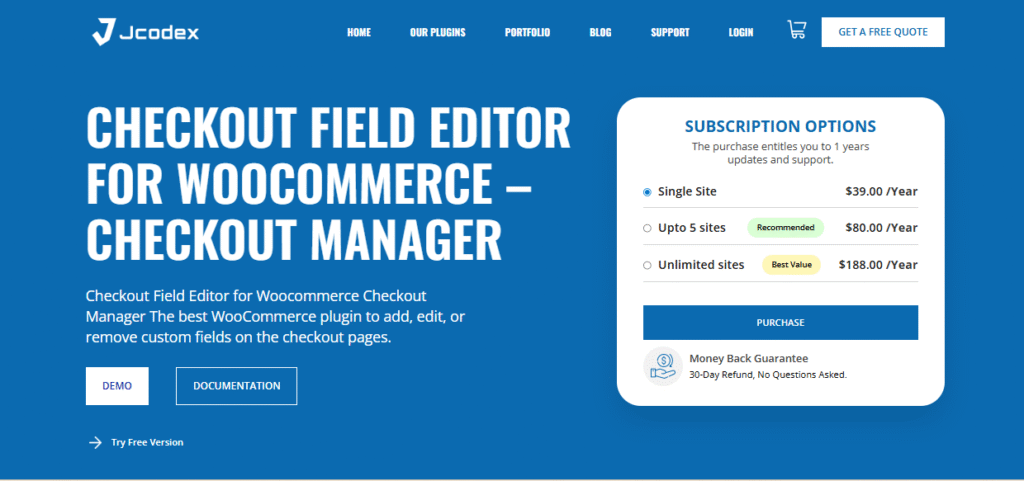
How to Edit Checkout Fields in WooCommerce (Step-by-Step)
Here’s how you can start customizing your checkout form today:
Step 1: Install the Plugin
- Download and install the free WooCommerce Checkout Field Editor plugin from WordPress.org.
Or purchase the Pro version for advanced features.
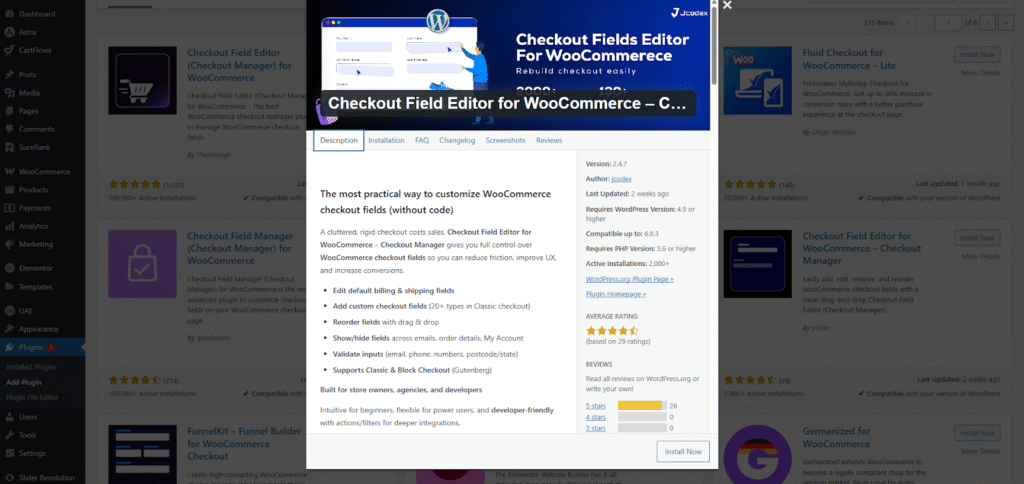
Step 2: Access Settings
Go to your WordPress dashboard → WooCommerce → Checkout Fields.
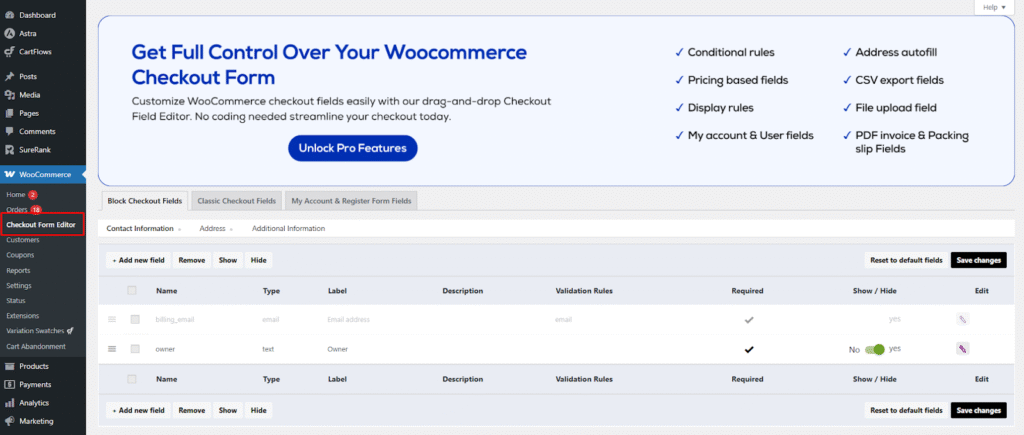
Step 3: Add New Fields
- Click Add Field and select the type (text, email, number, dropdown, checkbox, etc.).
- Customize the label, placeholder, and whether it’s required or optional.
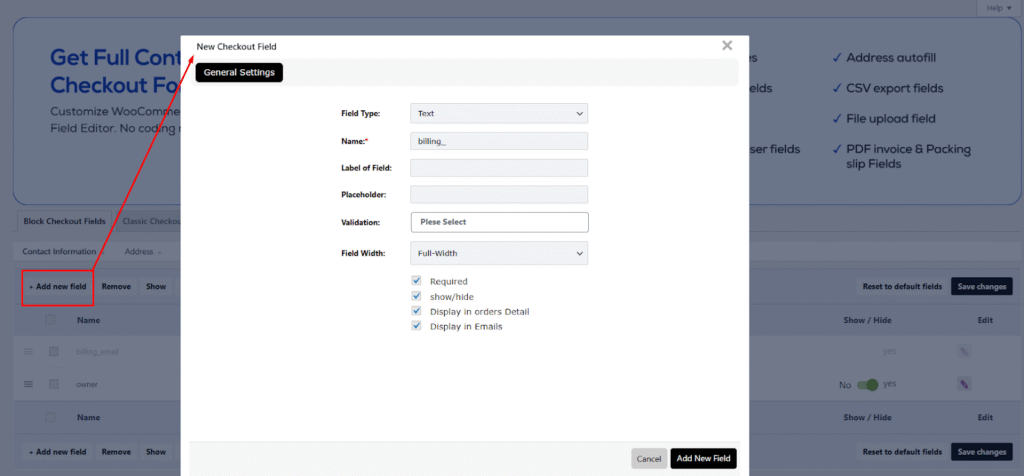
Step 4: Edit or Remove Existing Fields
- Modify default WooCommerce fields like Address, Phone, or Email.
- Remove irrelevant fields to make checkout cleaner.
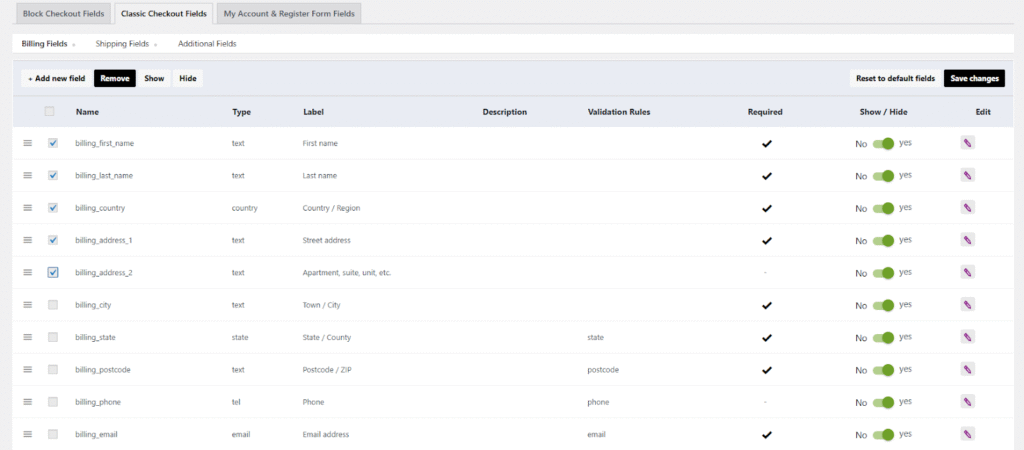
Step 5: Apply Conditional Logic (Pro)
- Show/hide fields based on customer selections.
- Example: Display a “Delivery Instructions” field only when the Local Pickup method is chosen.

Step 6: Save and Test
- Save your changes.
- Test the checkout process to make sure everything works smoothly.
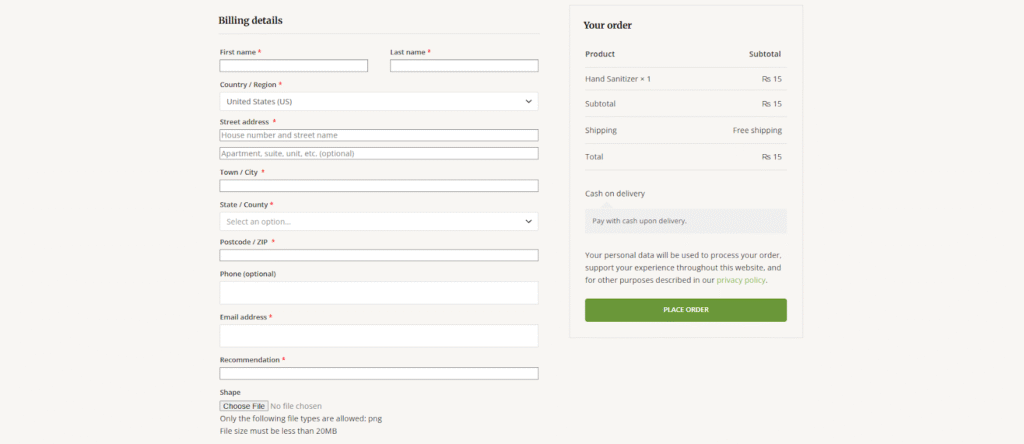
Free vs Pro: Which Version Do You Need?
Both versions of the plugin are powerful, but choosing the right one depends on your store’s requirements.
Free Version – Best for Beginners
- Add, edit, or remove checkout fields
- Basic field types (text, email, number, checkbox, radio, dropdown)
- Drag-and-drop reordering
- Perfect for small stores or simple needs
If you’re just starting out and need simple checkout customization.
Pro Version – Best for Advanced Stores
- All free features included
- Conditional logic
- File upload fields
- Advanced input types (date picker, time picker, etc.)
- Field visibility rules (based on role, product, or category)
- Priority support
If you’re running a growing WooCommerce store, the Pro plugin can give you maximum flexibility and control.
Advanced Use Cases for WooCommerce Checkout Customization
Let’s look at real-world scenarios where a WooCommerce checkout manager makes a big difference:
- B2B Wholesale Store: Collect company name, VAT number, and tax ID.
- Event Ticketing Website: Add attendee details like names, ages, and preferences.
- Gift Shop: Add gift messages, recipient addresses, or delivery dates.
- Service-Based Business: Collect service preferences or appointment details.
- Custom Products: Add file upload fields for logos, images, or design files.
The possibilities are endless once you start using a WooCommerce checkout editor plugin.
SEO Benefits of Checkout Customization
Interestingly, customizing your checkout fields also supports SEO and user retention indirectly:
- Lower Cart Abandonment Rate → Improves conversion rate optimization (CRO)
- Better User Experience → Increases customer satisfaction and repeat orders
- More Customer Data → Helps you refine email marketing and personalization campaigns
- Fewer Support Requests → Customers provide the right details at checkout, reducing errors
A well-optimized checkout doesn’t just improve sales, it helps your entire business ecosystem.
FAQs about WooCommerce Checkout Field Editor
1. What is a WooCommerce Checkout Field Editor?
It’s a plugin that allows you to add, edit, and remove checkout form fields without coding.
2. Can I remove unwanted checkout fields?
Yes, you can easily remove fields like Company Name or Address Line 2 if not needed.
3. Can I add custom fields such as a Date Picker or a File Upload?
Yes, the Pro version supports advanced fields like date pickers, file uploads, and conditional logic.
4. Does it work with all WooCommerce themes?
Yes, our plugin is compatible with most WooCommerce themes and payment gateways.
5. Is it beginner-friendly?
Absolutely. It comes with a drag-and-drop interface that’s easy to use even for non-technical users.
6. Can I create conditional fields?
Yes, with the Pro version, you can show/hide fields based on user role, product, category, or selected shipping method.
Conclusion
The checkout page is the most critical step in the customer journey. A poorly optimized form can cost you sales, while a customized one can boost conversions and customer satisfaction.
By using the WooCommerce checkout field editor plugin, you can:
- Simplify the checkout process
- Add custom fields that suit your business needs
- Collect accurate data from customers
- Reduce cart abandonment
We recommend you start with the free version to get hands-on experience. After that, if you need the premium features, consider updating to Pro.
With the right WooCommerce checkout editor, you’ll take full control of your checkout page and create a shopping experience your customers will love.
Help us grow by sharing this Post!


